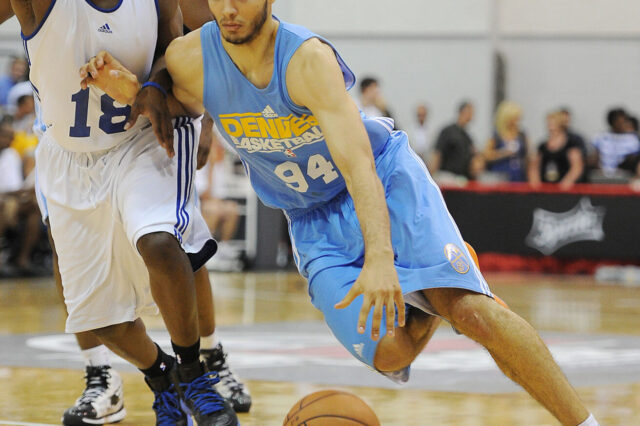Jamal Murray was struggling in his NBA playoff debut. Through the first three games of the series against the San Antonio Spurs, the Blue Arrow was shooting just 39.1% from the field and 28.6% from the three-point line. He had as many turnovers as assists and, outside of a red-hot 4th quarter in game two, he was getting outplayed by his counterpart, Derrick White. As a team, the Nuggets were in a 2-1 hole and facing a must-win game four on the road with absolutely no momentum and a young team that was on the brink of losing hold of the proverbial rope.
In the two games since then, the Nuggets have retaken the lead in the series behind a pair of impressive bounce-back performances by Murray. In that stretch, Murray is averaging 23.5 points per game, shooting 56.7% from the field, and 50% from the three-point line with 13 total assists and just 3 turnovers.
So what changed for the Nuggets and their young point guard? Many things, but perhaps none more important to Murray’s offensive game than a change-up to the team’s approach to ball screens.
The Nuggets like to set soft screens in the pick-and-roll (PnR). The “soft” part of that sentence isn’t quite what it sounds like; a weak, timid un-screen where the screener is afraid to make contact. Rather, soft screens like the ones in the clip below are a staple of the PnR in today’s NBA.
The idea is that the goal of a ball screen in 2019 is different than what it was in 1999. Instead of trying to free up the ball-handler to turn the corner into a contested mid-range jump shot, the goal of these types of soft screens is to set the screen in a spot that forces the on-ball defender to fight high over the screener. Ideally, this places the defense behind the play and allows the guard to attack the rim protector two-on-one with the rolling big. This type of PnR screening was popularized by Mike D’Antoni and is still a staple of the Houston Rockets’ dynamic PnR between James Harden and Clint Capela.
Through the first three games of Nuggets-Spurs series, the San Antonio Spurs have thrown a wrench in that style of attack. Jokic’s lack of vertical athleticism and Derrick White’s skill at fighting through screens and contesting from behind have allowed the Spurs to drop their big deep into the paint, walling off drives to the rim and conceding mid-range pull-up jumpers. But with those soft ball screens, White has been able to contest Murray’s shots from behind. The result was that as Murray would turn the corner he wouldn’t see a lane to the rim or create enough separation to pull-up from the free throw line.
Heading into game four, Nuggets head coach Michael Malone hinted at a new approach that included a need to “lay some wood” on screens.
“Give them credit, they set screens. They make contact. They make us feel them on that end of the floor. We have to hit bodies, we have to make contact.”
In game four, the Nuggets started setting the hard screen. First, that opened up the mid-range pull-up for Jamal Murray, a shot he knocked down at a 55.5% clip on fairly decent volume throughout the regular season. Eventually, the harder screens also drew the big further out of the paint, opening up angles for dropoff passes to Jokic on the roll.
The big stepping out further on PnRs also allowed Murray to use hesitation moves to keep the defense guessing. Below, watch how LaMarcus Aldridge tries to wall off the paint long enough to stop Murray from driving while also guessing when to release back to Jokic on the kickout. But Murray stays patient and in control of his dribble, picking the perfect moment to attack Aldridge as he begins to release toward Jokic.
In game five, with a bit of momentum carrying over from the previous game, Murray did a near perfect job running the offense while reading and reacting to what the defense gave him. In the clips below, the Nuggets run (nearly) the exact same Millsap-Murray PnR action three plays in a row. In the first two examples, Patty Mills reads the play and tried to cut off Murray’s angle toward the screen. But rather than force the action, Murray goes off-script to take advantage of Mills jumping out of position to stop the drive. He drags the defender far enough away to create a wide open three-pointer for Millsap.
The second and third examples provide a few fun Easter Eggs. Watch how Gary Harris, having just seen how the Spurs defended the action, sets a screen on Aldridge to free up a pass for Millsap on the second play. In the third clip, which came out of a timeout, watch how Millsap flips the screen and allows Murray to snake back toward the paint and force a switch. From there, Murray gives Millsap an easy mouse-in-the-house bucket.
These types of reads are the key to Murray unlocking his potential as a scoring point guard. He can be explosive as a scorer but playing the point guard position requires that he balance a scorer’s mindset with the mindset of a facilitator. Being able to read when to stick to the script and when to improvise is at the heart of that balance.
With Murray back in rhythm and scoring at a high rate, the Nuggets were able to get the ball poppin’ again in the half court. Possessions like the one below are quintessential Nuggets basketball. White tries to duck under the screen but with Aldridge pulled further out toward the three-point arc, Murray is able to turn the corner and force a switch. From there, rather than force an isolation against Aldridge or a post-up for Jokic against White, the Nuggets balance the floor and get the ball inside, outside, and around the arc.
The Spurs never stood a chance.
With Murray drawing the big further out on the court and the Nuggets offense demonstrating patience and ball movement, the team has regained one of their biggest regular season advantages: rebounding. The Nuggets were the 3rd best rebounding team in the regular season but were out-rebounded 142-124 through the first three games, losing the rebounding battle in each of those games. With more dribble penetration and ball-movement, the Nuggets have been able to scramble the Spurs’ defense, opening up rebounding lanes and second chance points.
The Spurs may come with an adjustment in game six or attempt to mix up their PnR coverage in an effort to confuse the 22-year-old point guard and keep him off balance. But after five games, Murray seems to have figured out his reads.
“I just think we’re a lot more prepared. I’ve never known a team so much,” Murray said with a smile following a win in game five. “You kind of know the personnel, know exactly what they are going to do.”


